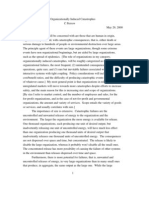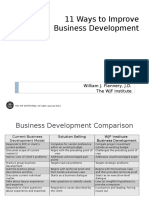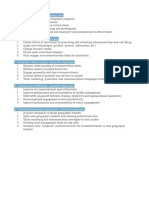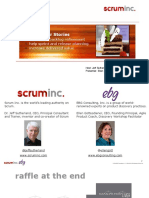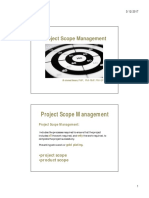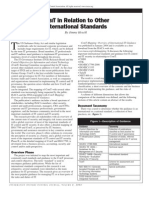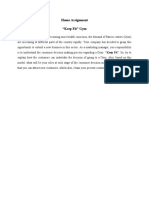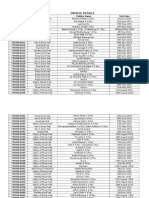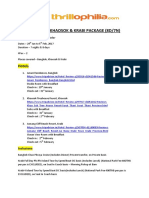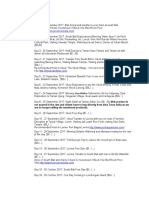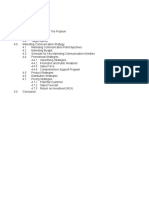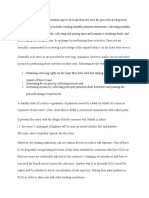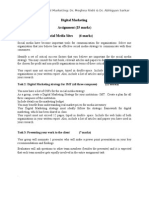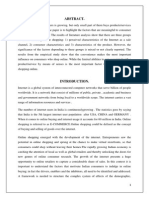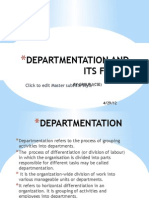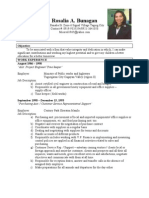Professional Documents
Culture Documents
Sapient Corporation Abridged Case
Uploaded by
Nitin JainCopyright
Available Formats
Share this document
Did you find this document useful?
Is this content inappropriate?
Report this DocumentCopyright:
Available Formats
Sapient Corporation Abridged Case
Uploaded by
Nitin JainCopyright:
Available Formats
A.What was Sapients strategy before 2007?
Sapient has aggressively pursued projects with complex scope, developed a reputation for delivering
business critical solutions, and turned around failing projects. Sapient is in the business of helping clients
solve their business problems and in the process growing itself into a type of company that can transform
the IT consulting industry. Sapient implemented many strategies over the course of its existence to
achieve its visions. In 2001, demand for IT consulting services declined forcing Sapient to strategically
transform its business to reduce the impact of revenue loss.
Founders Greenburg and Moore, noticing a trend of time-and-material billing to clients, adopted a fixed-
price, fixed-duration business strategy from their previous firm. In addition, they went away from
another common trend of startup IT firms by not relying on venture capital. They were concerned that
having stakeholders would make it difficult for them to grow the company with their strategies. A key
strategy they wanted to fully control was Sapients identity, in other words its strategic context.
Sapients strategic context encompassed the purpose, core values, vision, goals and client value
proposition. Sapients employees actions were connected to the strategic context (Khurana &
Podolny, 2005, pp. 24-25). Sapients purpose was being a great company enabling human potential
(Khurana & Podolny, 2005, p. 7). The great company was specified to be on a legendary commitment
to client success and routinely achieving the impossible. This attitude to take on improbable or risky
ventures paid off for Sapient as it endorsed technology trends before they were in wide adoption.
Sapient embraced the internet technology at the early stage of the development and won more clients
by helping them realize how the internet was going to change their business. Sapient not only delivered
on their promise of on time, on budget, but focused on building strong client relations. Sapients purpose
and core values were an important part of how they interacted with their clients. One key component of
client value proposition was Sapients brand promise to do whatever it takes to deliver the right
business results on time and on budget. The client value proposition was the articulation of the value
Sapient provided to its clients (Khurana & Podolny, 2005, p. 8).
B.What features of Sapients organizational structure impact (positively or
negatively) on the companys ability to execute their strategy?
Sapients organizational structure was not segmented by industry, such as financial services,
telecommunications, or energy, before 1996. Instead, the organizational structure was organized
geographically. The geographical organization got in the way of leveraging their industry expertise. The
business management team realized their mistake and reorganized Sapient by industry and by practice
domain such as SAP or CRM. The new structure developed a new set of leaders and accelerated Sapients
growth.
C.What roles have vision and values played in the success of Sapient?
Sapients culture was at the nucleus of its success. Sapients culture was influenced by vision and values
which are based on creativity, leadership, openness, people growth, client-focused delivery, and
relationships (Khurana & Podolny, 2005, p. 26). Sapients employees identified and were motivated by
culture. For Sapient leadership, it made sense to hire people who better fit the culture, possibly even
trading off some immediate skills necessary for the specific entry job (Chatman & Cha, 2003, p26.).
Sapient used extensive questionnaires to ensure that new recruits were a strong fit for Sapients culture.
The focus on values favored both the recent graduates and experienced professionals from outside the
consulting industry. Once hired, individuals were constantly challenged to demonstrate core values while
satisfying their client needs. Sapient leveraged its values in acquisitions as well. During one particular
instance, a founder of the company being acquired stated that from the moment Sapient started to
integrate us, the core values were right there (Khurana & Podolny, 2005, p. 9).
D.How closely do you think Sapient adhered to its values during the various phases of its evolution?
Early Years (November, 1990 mid 1994): Sapient created the company and established the core values
that would be used to build a successful business. Dedication and strict adherence to these values
resulted in a significant growth of the business as the company established a reputation for adaptability,
excellence, and customer satisfaction. The company created a developmental approach
(Sapient|Approach) to enable clients to deliver results quickly. Greenberg and Moore trained all
employees on the strategic context, thus ensuring that Sapientss purpose, core values, vision, goals,
and client value proposition were followed (Khurana & Podolny, 2005, p. 7).
Internet Growth Period (mid 1994 early 2000): During this period, the company grew very quickly.
Sapient went public in 1996, and later acquired Exor Technologies, Studio Archetype, Adjacency, and E-
Lab. Sapient continued to emphasize its values with the new acquisitions. A founder of a Sapient-
acquired company said, we have pretty consistently seen the company behave according to the core
values it presented to us when we were first acquired (Khurana & Podolny, 2005, p. 9). Sapient moved
some of its development to India, enabling it to respond to client pressure to reduce prices and satisfy
the companys increased client base.
Turmoil and Burst of the Internet Bubble (late 2000 2002): This was a difficult period, where many IT
companies were failing. Sapient adhered to its core values, but pressures to reduce costs resulted in
significant layoffs of Sapient staff. Concern about layoffs caused the company to become inwardly
focused. As Sapient transitioned more of its business to India, it was forced to spend more time
integrating its core values into the new culture. Sheeroy Desai, Sapients COO, said, I think that in the
dot-com era, we found ourselves compromising on how we lived our values on a whole bunch of things
all of which contributed to the down cycle (Khurana & Podolny, 2005, p. 16).
The Recovery (Third Quarter of 2003 Forward): Sapient again focused on its core values, using
ChapterNext where they stressed the companys purpose, vision, goals, and values. This period also
resulted in a return to profitability for the company.
E.To what degree is the Sapient reward system conducive to selection, development, and retention
of individuals committed to its purpose and values?
During Sapients early growth, they hired people with strong interpersonal skills, organizational fit, and a
passion for solving business problems. They emphasized technical skills, but did not make them a
prerequisite for hiring. Base compensation was below industry average, and they used bonuses and stock
options to enable high performers to increase their pay. Sapient also used nonmonetary awards to
recognize star employees who demonstrated strong core values.
During the internet boom, Sapient did not require that new recruits put a significant fraction of their
compensation at risk. These individuals then proved to be less motivated to align with Sapient's core
values. Except for that period of time, Sapients reward system was very conducive to growing and
retaining personnel who were committed to its purpose and values.
F.How does the growth of the organization relate to the meaning that individuals derive from
working for this organization?
Interpretation of the Sapient Culture
Purpose => Core Values => Passion=> Motivation => Successful implementations => Satisfied Customers =>
Growth => Pride, Self Satisfaction and Personal Growth
Individuals working for this organization have a sense of pride directly linked to the health of the
organization. In fact, there is an underlining process or cycle that leads to the connection between
company growth and individual satisfaction. During the time when the company was first established,
the founders focused on a culture centered on purpose. The purpose being a great company enabling
human potential was simple, but it wasnt granular enough for individuals to be able to apply it to their
everyday activities (Khurana &Podolny, 2005, p. 7). Company leaders recognized the gap and developed
six distinct core values. These values could be directly applied to employee performance inherently
making them aware of the impact their actions have on the companys reputation. The values instilled a
sense of passion in individuals which translated into motivation for their service and work they provided
their clients. Motivation further translated to highly successful engagements measured by client approval
and satisfaction. This chain reaction led to repeat business and organizational growth. As the company
prospered, individuals were able to directly link the positive change to their effort and hard work leaving
them with a feeling of self fulfillment and personal growth.
G.What are the key leadership challenges to keep this type of company moving forward?
The challenges for this leadership are dependent on the direction that they want to take the company.
Greenberg and Moore have used the word impact to describe their aspirations for the company and
would like to grow it from midsize to very large company equivalent to a Wal-Mart or Southwest for the
IT consulting industry. Moore has expressed that beyond being profitable; his goal is not only to take the
company but the industry to a fundamentally different level (Khurana & Podolny, 2005, p. 17). The
biggest challenge in accomplishing his goals will be to sustain the unique culture while growing to new
heights. As the firm grows, it will need to adjust and adapt its culture with its business strategy. As
noted by Chatman and Cha in Leading by Leveraging Culture, An effective culture is closely related to
business strategy.using culture as a leadership tool is that it must be strategically relevant. If the two
are not intertwined, the growth of the company will not be sustainable.
On the journey to becoming an industry giant, organizations often experience unexpected obstacles such
as economic or industry-driven hardships. A common pitfall of companies experiencing hardship is the
compromise of an effective culture (Chatman & Cha, 2003, p. 29). Sapient has faltered once before
when it compromised its values during the burst of the internet bubble by hiring senior management
outside of its normal hiring process. Moore and Greenberg will have to overcome this challenge and take
initiative to remain consistent with their values. Another key challenge for Sapient will be to see how it
will need to adapt its consulting approach to variable client needs in the future. Moores vision to grow
the company extensively will more than likely come at a price. In the past, Sapient has prided itself on
focusing on client business problems as opposed to just satisfying client needs. For a company looking to
grow, will they be willing to forego lucrative contracts in order to keep conducting business in their one
dimensional Sapient|Approach? While the approach is somewhat flexible, it is not for every client in
every situation. There is no evidence that their canned approach will be effective on large contracts
as it has been on small to midsize contracts and clients. Sapients leaders will need to take this under
consideration and devise a strategy to offset any risks of growing to a larger firm while maintaining their
strong organizational culture.
Section 2: Lessons Learned
A.What did you learn from completing this case?
We learned the importance of core values and how concentrating on growth can negatively impact an
organization. If an organization can refocus on their core values, it can leverage this as a tool making it
more resilient during economic hardships. There was a negative concept on how growth can be
perceived through an organization quoted from a consultant of Sapient; Growth is the addiction or
necessary drug for this company (Khurana & Podolny, 2006, p. 14). We never knew how growth can
steer an organization from their core values. It is these core values that are the pure essence of the
organizational culture. We learned that in order to effectively leverage core values, the leadership must
link them to employee actions in a direct way. This is so that an employee can use them as a
motivational tool. Most of us in the group work for large corporations where most of our coworkers
perceive their core values as having minimal impact on the success of the organization. If our
organization could implement a culture that is closely related to its purpose, than core values could
drive success and growth. Using this method could turn growth into a positive driver instead of
something negative.
B.How might you use this information in your current or future job?
In our current job, we would use this information to get in touch with our culture and understand the
core values that drive our organization. In addition, we would provide feedback to our superiors. This
feedback would include how they can impact the day-to-day actions of others including themselves by
making sure they define the core values to line up with our culture. We would also evaluate if our
current leaders are actually walking the talk and not feeding into the growth drug.
In our future jobs, we will look for culture and core values to be a proponent in our decision to work at
an organization. If our goals and core values are not aligned with the organizations, then we would think
twice before we would consider working there. In addition, we will make sure an organization does not
identify growth as a core value, but instead treats it as a product of success. This will be a quick
indicator whether our goals and core values are aligned with the values of the organization.
In our future jobs as leaders, we need to help define the core values and focus on considering how new
employees will fit in our organizational culture. Clearly defining the organizations core values to
employees can be the key ingredient in guarding against obstacles such as economic hardships that can
destroy even a well-established culture. As leaders, we must hire employees that better fit in our
culture even if it means hiring individuals with weaker IT skills (Chatman & Cha, 2003, p. 26).
You might also like
- 032431986X 104971Document5 pages032431986X 104971Nitin JainNo ratings yet
- Job Interview With AnswersDocument11 pagesJob Interview With Answersradu26titiNo ratings yet
- Government Legal Issues in CompensationDocument36 pagesGovernment Legal Issues in Compensationsheebakbs5144No ratings yet
- Stretagy For New India @75Document240 pagesStretagy For New India @75Deep GhoshNo ratings yet
- 4.2 Shell Oil Workers' Union Vs Shell CompanyDocument2 pages4.2 Shell Oil Workers' Union Vs Shell CompanyHiroshi AdrianoNo ratings yet
- Six SigmaTraining OfferingDocument16 pagesSix SigmaTraining OfferingAshitosh BabarNo ratings yet
- B.1. Fase Preliminar - Modelo de Organización de La Arquitectura Empresarial. - TOGAF 9 Template - Organizational Model For Enterprise ArchitectureDocument9 pagesB.1. Fase Preliminar - Modelo de Organización de La Arquitectura Empresarial. - TOGAF 9 Template - Organizational Model For Enterprise ArchitectureEduardo VegaNo ratings yet
- Perrow Normal AccidentDocument8 pagesPerrow Normal AccidentNick GogertyNo ratings yet
- Benchmark Six Sigma Consulting BrochureDocument4 pagesBenchmark Six Sigma Consulting BrochureMrinmoy An AmbidextrousNo ratings yet
- Pharmaceutical industry business capability mapDocument1 pagePharmaceutical industry business capability mapMarco Vinicio LenciNo ratings yet
- 11 Ways To Improve Business Development: William J. Flannery, J.D. The WJF InstituteDocument27 pages11 Ways To Improve Business Development: William J. Flannery, J.D. The WJF InstituteRobert JamesNo ratings yet
- Mapping CMMI Project Management Process Areas To SCRUM PracticesDocument10 pagesMapping CMMI Project Management Process Areas To SCRUM PracticesGlezMikelNo ratings yet
- The State of EnterpriseDocument16 pagesThe State of EnterprisenicolepetrescuNo ratings yet
- MB0049Document21 pagesMB0049Dipika KumariNo ratings yet
- Human Capital - Planned Responses: CEO Concerns 2015Document3 pagesHuman Capital - Planned Responses: CEO Concerns 2015EdjeSNo ratings yet
- DCOVA FrameworkDocument1 pageDCOVA FrameworkbharathiNo ratings yet
- Sap Senior Application Consultant Hitachi Zosen Inova AgDocument17 pagesSap Senior Application Consultant Hitachi Zosen Inova AgRamiro SanchezNo ratings yet
- Sop Maturity ModelDocument4 pagesSop Maturity ModelarrivaNo ratings yet
- Technique ExampleDocument22 pagesTechnique ExampleDivya SaravananNo ratings yet
- Computing PolicyDocument12 pagesComputing Policyaami6No ratings yet
- Strategic Performance ManagementDocument11 pagesStrategic Performance ManagementvvvasimmmNo ratings yet
- The Balanced Scorecard (BSC) Method: From Theory To PracticeDocument12 pagesThe Balanced Scorecard (BSC) Method: From Theory To Practicecpriya tarsshiniNo ratings yet
- S4H - 074 How To Approach Fit To Standard Analysis - CloudDocument16 pagesS4H - 074 How To Approach Fit To Standard Analysis - CloudGasserNo ratings yet
- APO10 Manage SuppliersDocument17 pagesAPO10 Manage Suppliersnyamsuren.mncertNo ratings yet
- Sanofi Aventis Test ReportDocument13 pagesSanofi Aventis Test ReportAnonymous nDsySleE100% (1)
- Digital Strategy TemplateDocument4 pagesDigital Strategy TemplateAbdisalam UnshurNo ratings yet
- Core Competencies of Business AgilityDocument1 pageCore Competencies of Business Agilityerpiyushkumar1No ratings yet
- Intro To Inflooens - Best Mortgage Loan Origination SystemDocument12 pagesIntro To Inflooens - Best Mortgage Loan Origination SysteminflooensNo ratings yet
- BA Program SyllabusDocument7 pagesBA Program SyllabusRam KumarNo ratings yet
- Question 1 of 15Document9 pagesQuestion 1 of 15mohamed goudaNo ratings yet
- IBM Banking Industry Framework FlyerDocument4 pagesIBM Banking Industry Framework Flyerruca05No ratings yet
- Material de Estudiante ALPC V032023A enDocument89 pagesMaterial de Estudiante ALPC V032023A enCharlineNo ratings yet
- CSQADocument12 pagesCSQAjafet100% (1)
- Editing With S - DEVELOP AuthorizationsDocument8 pagesEditing With S - DEVELOP Authorizationsjcasselman01No ratings yet
- Product Breakdown Structure TemplateDocument4 pagesProduct Breakdown Structure TemplatedanacristinailieNo ratings yet
- Requirement Elicitation Research PaperDocument11 pagesRequirement Elicitation Research PaperUzma Noorin0% (1)
- Planning of CRM ProjectDocument8 pagesPlanning of CRM ProjectcatchardipNo ratings yet
- BRM Certification Summary - AqontaDocument3 pagesBRM Certification Summary - AqontaAqonta0% (1)
- Lean Six Sigma Black Belt Training Course - KPMG - inDocument6 pagesLean Six Sigma Black Belt Training Course - KPMG - inBhagath KrishnanNo ratings yet
- Agile Product Roadmap Tutorial: Roman Pichler'sDocument25 pagesAgile Product Roadmap Tutorial: Roman Pichler'smy nNo ratings yet
- QuesDocument12 pagesQuesCharlie ChampNo ratings yet
- Wipro Run SAP Simplifying Complex Application Landscapes White Paper 0312Document7 pagesWipro Run SAP Simplifying Complex Application Landscapes White Paper 0312Gayatri PandaNo ratings yet
- Organizations adopting project governance practices to improve strategic alignment and reduce failuresDocument14 pagesOrganizations adopting project governance practices to improve strategic alignment and reduce failuresanasmatarNo ratings yet
- Vidhi Shrivastava - SR Project Manager CVDocument6 pagesVidhi Shrivastava - SR Project Manager CVshridharpkNo ratings yet
- Blue BankDocument3 pagesBlue BankDream SquareNo ratings yet
- IBM Slide CHAPTER 3Document48 pagesIBM Slide CHAPTER 3Wen Xin GanNo ratings yet
- Business Analyst Change Management in North NJ Resume Lana GropenDocument3 pagesBusiness Analyst Change Management in North NJ Resume Lana GropenLanaGropenNo ratings yet
- SCRUM - USer Story WrittingDocument33 pagesSCRUM - USer Story WrittingMariel KleinerNo ratings yet
- Sales Pitch Ver 1.0 29122020Document16 pagesSales Pitch Ver 1.0 29122020SheebaNo ratings yet
- 2 - Project Scope Management PDFDocument21 pages2 - Project Scope Management PDFAhmed AwwadNo ratings yet
- IIA Milwaukee Chapter Data Analytics Forum - Agenda October 12, 2017Document64 pagesIIA Milwaukee Chapter Data Analytics Forum - Agenda October 12, 2017bapajanNo ratings yet
- Project Vs ProductDocument18 pagesProject Vs ProductS R Krishnan100% (3)
- Agile Software DevelopmentDocument5 pagesAgile Software Developmentsouma_it16No ratings yet
- Siemens MSP Case Study 2Document6 pagesSiemens MSP Case Study 2pasareaNo ratings yet
- Enhancing The Capability of ChatbotsDocument7 pagesEnhancing The Capability of ChatbotsVIVA-TECH IJRINo ratings yet
- Cobit in Relation To Others International StandardsDocument4 pagesCobit in Relation To Others International StandardsBoyke NurhidayatNo ratings yet
- 2019 Six - Practices - For - Effective - Portfolio - MGMT - 385064Document13 pages2019 Six - Practices - For - Effective - Portfolio - MGMT - 385064LauraNo ratings yet
- Home Assignment CDMPDocument1 pageHome Assignment CDMPASHIFA ASHRAFINo ratings yet
- Tech Mahindra Integrated Report 2017 18Document119 pagesTech Mahindra Integrated Report 2017 18ketan0077No ratings yet
- Ibm MicrofinanceDocument12 pagesIbm MicrofinanceRumba Guaguancò100% (1)
- Experienced Business Analyst with Expertise in Capital Markets and AnalyticsDocument4 pagesExperienced Business Analyst with Expertise in Capital Markets and AnalyticsArpit YadavNo ratings yet
- Visual Template StoryboardDocument7 pagesVisual Template StoryboardNidia Lizeth Diaz HerreraNo ratings yet
- Tcs Presentation1Document14 pagesTcs Presentation1Waibhav KrishnaNo ratings yet
- Integrated Business Planning A Complete Guide - 2020 EditionFrom EverandIntegrated Business Planning A Complete Guide - 2020 EditionNo ratings yet
- Operational Readiness Review A Complete Guide - 2020 EditionFrom EverandOperational Readiness Review A Complete Guide - 2020 EditionNo ratings yet
- Thrillophilia Invoice DetailsDocument12 pagesThrillophilia Invoice DetailsNitin JainNo ratings yet
- Mayank ThailandDocument4 pagesMayank ThailandNitin JainNo ratings yet
- Sentosa Fun Pass: Ticket Option Days of Operation Pick-Up TimeDocument1 pageSentosa Fun Pass: Ticket Option Days of Operation Pick-Up TimeNitin JainNo ratings yet
- 19d18n Bali Tour Program 18sep-06oct2017 - Updated 08122017Document2 pages19d18n Bali Tour Program 18sep-06oct2017 - Updated 08122017Nitin JainNo ratings yet
- Top Ladakh Trekking, Biking, and Sightseeing ToursDocument4 pagesTop Ladakh Trekking, Biking, and Sightseeing ToursNitin JainNo ratings yet
- Hardy-Weinberg Model & Sickle Cell DiseaseDocument4 pagesHardy-Weinberg Model & Sickle Cell DiseaseNitin JainNo ratings yet
- D1Document1 pageD1Nitin JainNo ratings yet
- Metabical ReportDocument9 pagesMetabical ReportNitin JainNo ratings yet
- Bass, B. M., & Stogdill, R. M., 1990)Document5 pagesBass, B. M., & Stogdill, R. M., 1990)Nitin JainNo ratings yet
- Control Plans - Exam 1Document2 pagesControl Plans - Exam 1Nitin JainNo ratings yet
- Annual Report 2010Document95 pagesAnnual Report 2010Nitin JainNo ratings yet
- Axis Bank Account StatementDocument3 pagesAxis Bank Account StatementNitin JainNo ratings yet
- D2Document1 pageD2Nitin JainNo ratings yet
- Neoliberalism: Pros and ConsDocument3 pagesNeoliberalism: Pros and ConsLlowell Williams100% (7)
- ABC Analysis For InventoryDocument30 pagesABC Analysis For InventoryNitin JainNo ratings yet
- CapProExample (1) 111111Document2 pagesCapProExample (1) 111111Nitin JainNo ratings yet
- SangeetDocument2 pagesSangeetNitin JainNo ratings yet
- Mess Newsletter Issue1Document15 pagesMess Newsletter Issue1Nitin JainNo ratings yet
- Trip PlanDocument1 pageTrip PlanNitin JainNo ratings yet
- Menswear SheetDocument15 pagesMenswear SheetNitin JainNo ratings yet
- Group assignment submission rules and test detailsDocument1 pageGroup assignment submission rules and test detailsNitin JainNo ratings yet
- TSG Breeze Product CatalogDocument14 pagesTSG Breeze Product CatalogNitin JainNo ratings yet
- Summer Internship - Application Form - Metro Cash & CarryDocument3 pagesSummer Internship - Application Form - Metro Cash & CarryNitin JainNo ratings yet
- SangeetDocument2 pagesSangeetNitin JainNo ratings yet
- Group 7 Sec-B BGSI Project SynopsisDocument3 pagesGroup 7 Sec-B BGSI Project SynopsisNitin JainNo ratings yet
- CRISIL Research Article Online Retail Feb14Document10 pagesCRISIL Research Article Online Retail Feb14Kanchan KumarNo ratings yet
- Group Project 25 MarksasDocument3 pagesGroup Project 25 MarksasNitin JainNo ratings yet
- SangeetDocument2 pagesSangeetNitin JainNo ratings yet
- Consumermotivationononlineshopping 140208015200 Phpapp01Document45 pagesConsumermotivationononlineshopping 140208015200 Phpapp01Nitin JainNo ratings yet
- Question CAP III AND CA MEMBERHSIP New OneDocument17 pagesQuestion CAP III AND CA MEMBERHSIP New OneSuraj ThapaNo ratings yet
- Department at Ion and Its FormsDocument13 pagesDepartment at Ion and Its Formsbharat_csm11No ratings yet
- A Hierarchical Model of The Internal Relationship Marketing Approach To Nurse Satisfaction and Loyalty PDFDocument20 pagesA Hierarchical Model of The Internal Relationship Marketing Approach To Nurse Satisfaction and Loyalty PDFHandsome RobNo ratings yet
- Ethical and Legal Issues in SellingDocument86 pagesEthical and Legal Issues in SellingMa'am RhonNo ratings yet
- Dual Representation Disclosure and Consent - Moss Adams LLP (Employee)Document4 pagesDual Representation Disclosure and Consent - Moss Adams LLP (Employee)SRISHTI MALHOTRANo ratings yet
- Mangaement Process School & Henri FayolDocument28 pagesMangaement Process School & Henri Fayolgunu_f1100% (8)
- Ra 7322Document2 pagesRa 7322theresagriggsNo ratings yet
- Wheebox Employability Skills Test ReportDocument12 pagesWheebox Employability Skills Test ReportNeelam KapoorNo ratings yet
- Globalisation in Nepal Assessment of Achievements and The Way ForwardDocument8 pagesGlobalisation in Nepal Assessment of Achievements and The Way ForwardMahendra ChhetriNo ratings yet
- Ankar ProjectDocument157 pagesAnkar ProjectSashi PandeyNo ratings yet
- Employee Turnover and Retention An Overv PDFDocument6 pagesEmployee Turnover and Retention An Overv PDFAna - Maria AvramNo ratings yet
- The Zeitgeist Movement UnderstandingsDocument16 pagesThe Zeitgeist Movement Understandingsfrnweihtu43No ratings yet
- Project ReportDocument68 pagesProject Reportarbaz kaziNo ratings yet
- MCD CR Report 08Document15 pagesMCD CR Report 08aster5262No ratings yet
- Rosalia Updated Resume 2Document3 pagesRosalia Updated Resume 2Grecopgg LasmariasNo ratings yet
- (PDF) A COMPARATIVE STUDY OF VEGETABLE AND FRUIT VENDORS UNDER DECENT WORK IN AHMEDABAD CITY, BKMIBA (1) Mili Sharma, AVI JAINDocument1 page(PDF) A COMPARATIVE STUDY OF VEGETABLE AND FRUIT VENDORS UNDER DECENT WORK IN AHMEDABAD CITY, BKMIBA (1) Mili Sharma, AVI JAINRINCONADA ReynalynNo ratings yet
- Public Discourse - Paternity Leave Position PaperDocument5 pagesPublic Discourse - Paternity Leave Position PapermegannaudeNo ratings yet
- Management Control SystemsDocument28 pagesManagement Control SystemsAnthony MaloneNo ratings yet
- Selecting The Global Sales ForceDocument19 pagesSelecting The Global Sales Forcesimply_cooolNo ratings yet
- National Construction Contracts and Law SurveyDocument24 pagesNational Construction Contracts and Law SurveyAndRew YNo ratings yet
- Ethics Case StudyDocument2 pagesEthics Case StudyOtonashii ManlapazNo ratings yet
- Archana Tata SteelDocument66 pagesArchana Tata SteelSanjay VeerabhadrakumarNo ratings yet
- CH - 5 - MCQsDocument4 pagesCH - 5 - MCQsSarthak BhagatNo ratings yet
- Health and Safety Policy GuideDocument7 pagesHealth and Safety Policy GuideLove100% (1)
- Toronto Ombudsman's Report On TCHCDocument111 pagesToronto Ombudsman's Report On TCHCToronto Star100% (1)







